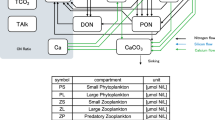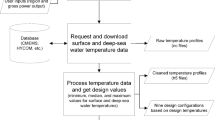Abstract
Artificial upwelling, as a geoengineering tool, has received worldwide attention because it may actualize ocean fertilization in a sustainable way, which could potentially alleviate the pressures on the fish stocks and human-driven climate change in the ocean. We reviewed the current knowledge on the development of an artificial upwelling system and its potential environmental effects. Special attention was given to the research progress on the air-lift concept artificial upwelling by Zhejiang University. The research on artificial upwelling over the past few decades has generated a range of devices that have been successfully applied in the field for months. Based on field experiments and the associated modeling results, part of them reported positive effects on increasing primary production and enhancing CO2 sequestration. However, as a significant disturbance to the environment, especially for large-scale applications, the uncertainties related to the potential effects on ecosystem remain unsolved. Zhejiang University has overcome the technical challenges in designing and fabricating a robust and high efficiency artificial upwelling device which has been examined in two field experiments in Qiandao Lake and one sea trial in the East China Sea. It was investigated that cold and hypoxic deep ocean water (DOW) could be uplifted to the euphotic layer, which could potentially change the nutrient distribution and adjust the N/P ratio. Both simulation and field experiments results confirmed that utilizing self-powered energy to inject compressed air to uplift DOW was a valid and efficient method. Therefore, further field-based research on artificial upwelling, especially for long-term field research is required to test the scientific hypothesis.
Similar content being viewed by others
References
Arrigo K R. 1999. Phytoplankton community structure and the drawdown of nutrients and CO2 in the southern ocean. Science, 283: 365–367
Aspetsberger F, Zabel M, Ferdelman T, Struck U, Mackensen A, Ahke A, Witte U. 2007. Instantaneous benthic response to different organic matter quality: In situ experiments in the benguela upwelling system. Mar Biol Res, 3: 342–356
Aure J, Strand Q, Erga S R S, Strohmeier T. 2007. Primary production enhancement by artificial upwelling in a western Norwegian fjord. Mar Ecol Prog Ser, 352: 39–52
Bauman S, Costa M, Fong M, House B, Perez E, Tan M, Thornton A, Franks P. 2014. Augmenting the biological pump: The shortcomings of geoengineered upwelling. Oceanography, 27: 17–23
Bechmann R K, Taban I C, Westerlund S, Godal B F, Arnberg M, Vingen S, Ingvarsdottir A, Baussant T. 2011. Effects of ocean acidification on early life stages of shrimp (Pandalus Borealis) and mussel (Mytilus Edulis). J Toxicol Env Heal A, 74: 424–438
Chen J W, Yang J, Lin S, Fan W, Chen Y, Liang N, Ge H, Huang H. 2013. Development of air-lifted artificial upwelling powered by wave. In: MTS/IEEE Oceans Conference, Sep 23–27, 2013. San Diego. 1–7
Chung C C, Gong G C, Hung C C. 2012. Effect of typhoon morakot on microphytoplankton population dynamics in the subtropical northwest pacific. Mar Ecol Prog Ser, 448: 39–49
Day L, McNeil I. 2003. Biographical Dictionary of the History of Technology Routledge. London: Routledge. 45–46
Dutreuil S, Bopp L, Tagliabue A. 2009. Impact of enhanced vertical mixing on marine biogeochemistry: Lessons for geo-engineering and natural variability. Biogeosciences, 6: 901–912
Fan W, Chen J, Pan Y, Huang H, Chen C T A, Chen Y. 2013. Experimental study on the performance of an air-lift pump for artificial upwelling. Ocean Eng, 59: 47–57
Fan W, Pan Y, Liu C C K, Wiltshire J C, Chen C T A, Chen Y. 2015. Hydrodynamic design of deep ocean water effluent discharge for the creation of a nutrient-rich plume in the SCS. Ocean Eng, 108: 356–368
Gao K S, Ruan Z X, Villafane V E, Gattuso J P, Helbling W. 2009. Ocean acidification exacerbates the effect of UV radiation on the calcifying phytoplankter Emiliania huxleyi. Limnol Oceanogr, 54: 1855–1862
Gaylord B, Hill T M, Sanford E, Lenz E A, Jacobs L A, Sato K N, Russell A D, Hettinger A. 2011. Functional impacts of ocean acidification in an ecologically critical foundation species. J Exp Biol, 214: 2586–2594
Handå A, McClimans T A, Reitan K I, Knutsen Ø, Tangen K, Olsen Y. 2013. Artificial upwelling to stimulate growth of non-toxic algae in a habitat for mussel farming. Aquac Res, 1–12
Isaacsa J D, Castela D, Wicka G L. 1976. Utilization of the energy in ocean waves. Ocean Eng, 3: 175–182
Keller D P, Feng E Y, Oschlies A. 2014. Potential climate engineering effectiveness and side effects during a high carbon dioxide emission scenario. Nat Commun, 5: 3304–3315
Kirke B. 2003. Enhancing fish stocks with wave-powered artificial upwelling. Ocean Coast Manage, 46: 901–905
Leinen M. 2008. Building relationships between scientists and business in ocean iron fertilization. Mar Ecol Prog Ser, 364: 251–256
Leng J, Chen J, Huang H, Lin S, Liu M, Liu J. 2014. Impact of structure design of artificial upwelling tube. Appl Mech Mat, 496–500: 547–550
Lenton T M, Vaughan N E. 2009. The radiative forcing potential of different climate geoengineering options. Atmos Chem Phys, 9: 2559–2608
Liang N, Peng H. 2005. A study of air-lift artificial upwelling. Ocean Eng, 32: 731–745
Liu C C K, Jin Q. 1995. Artificial upwelling in regular and random waves. Ocean Eng, 22: 337–350
Lovelock J E, Rapley C G. 2007. Ocean pipes could help the earth to cure itself. Nature, 449: 403
Masuda T, Furuya K, Kohashi N, Sato M, Takeda S, Uchiyama M, Horimoto N, Ishimaru T. 2011. Lagrangian observation of phytoplankton dynamics at an artificially enriched subsurface water in Sagami Bay, Japan. J Oceanogr, 66: 801–813
Maruyama S, Tsubaki K, Taira K, Sakai S. 2004. Artificial upwelling of deep seawater using the perpetual salt fountain for cultivation of ocean desert. J Oceanogr, 60: 563–568
Maruyama S, Yabuki T, Sato T, Tsubaki K, Komiya A, Watanabe M, Kawamura H, Tsukamoto K. 2011. Evidences of increasing primary production in the ocean by Stommel’s perpetual salt fountain. Deep-Sea Res Part I-Oceanogr Res Pap, 58: 567–574
McClimans T A. 2008. Improved efficiency of bubble curtains. In: Proceedings, Coastal Technology Workshop Trondheim, Norway
McClimans T A, Handå A, Fredheim A, Lien E, Reitan K I. 2010. Controlled artificial upwelling in a fjord to stimulate non-toxic algae. Aqua Eng, 42: 140–147
Meng Q, Wang C, Chen Y, Chen J. 2013. A simplified CFD model for air-lift artificial upwelling. Ocean Eng, 72: 267–276
Meyer L, Cooper D, Varley R. 2011. Are we there yet? A developer’s roadmap to OTEC commercialization. MTS.
Mizumukai K, Sato T, Tabeta S, Kitazawa D. 2008. Numerical studies on ecological effects of artificial mixing of surface and bottom waters in density stratification in semi-enclosed bay and open sea. Ecol Model, 214: 251–270
Moore J K, Lindsay K, Doney S C, Long M C, Misumi K. 2013. Marine ecosystem dynamics and biogeochemical cycling in the community earth system model [CESM1(BGC)]: Comparison of the 1990s with the 2090s under the RCP4.5 and RCP8.5 scenarios. J Clim, 26: 9291–9312
Oschlies A, Pahlow M, Yool A, Matear R. 2010. Climate engineering by artificial ocean upwelling: Channelling the Sorcerer’s apprentice. Geophys Res Lett, 37: 1–5
Ouchi K, Otsuka K, Omura H. 2005. Recent advances of ocean nutrient enhancer “TAKUMI” project. In: Proceeding of the Sixth ISOPE Ocean Mining Symposium. Changsha, Hunan, China. 7–12
Pan Y, Fan W, Huang T-H, Wang S-L, Chen C-T A. 2015. Evaluation of the sinks and sources of atmospheric CO2 by artificial upwelling. Sci Total Environ, 511: 692–702
Sakka Hlaili A, Chikhaoui M A, El Grami B, Hadj Mabrouk H. 2006. Effects of N and P supply on phytoplankton in Bizerte lagoon (Western Mediterranean). J Exp Mar Biol Ecol, 333: 79–96
Schiermeier Q. 2007. Mixing the oceans proposed to reduce global warming. Nature, 449: 781
Stommel H, Arons A B, Blanchard D. 1953. An oceanographical curiosity: The perpetual salt fountain. Deep Sea Res, 3: 152–153
Takahashi T, Sutherland S C, Wanninkhof R, Sweeney C, Feely R A, Chipman D W, Hales B, Friederich G, Chavez F, Sabine C, Watson A, Bakker D C E, Schuster U, Metzl N, Yoshikawa-Inoue H, Ishii M, Midorikawa T, Nojiri Y, Körtzinger A, Steinhoff T, Hoppema M, Olafsson J, Arnarson T S, Tilbrook B, Johannessen T, Olsen A, Bellerby R, Wong C S, Delille B, Bates N R, de Baar H J W. 2009. Climatological mean and decadal change in surface ocean pCO2, and net sea-air CO2 flux over the global oceans. Deep-Sea Res Part II-Top Stud Oceanogr, 56: 554–577
Tsubaki K, Maruyama S, Komiya A, Mitsugashira H. 2007. Continuous measurement of an artificial upwelling of deep sea water induced by the perpetual salt fountain. Deep-Sea Res Part I-Oceanogr Res Pap, 54: 75–84
Vershinskiy N V. 1987. Artificial upwelling using the energy of surface waves. Oceanology, 27: 400–402
Weikert H. 1977. Copepod carcasses in the upwelling region south of Cap Blanc, N.W. Africa. Mar Biol, 42: 351–355
White A, Björkman K, Grabowski E, Letelier R, Poulos S, Watkins B, Karl D. 2010. An open ocean trial of controlled upwelling using wave pump technology. J Atmos Ocean Tech, 27: 385–396
Williamson N, Komiya A, Maruyama S, Behnia M, Armfield S. 2009. Nutrient transport from an artificial upwelling of deep sea water. J Oceanogr, 65: 349–359
Williamson P, Wallace D W R, Law C S, Boyd P W, Collos Y, Croot P, Denman K, Riebesell U, Takeda S, Vivian C. 2012. Ocean fertilization for geoengineering: A review of effectiveness, environmental impacts and emerging governance. Process Saf Environ, 90: 475–488
Yool A, Shepherd J G, Bryden H L, Oschlies A. 2009. Low efficiency of nutrient translocation for enhancing oceanic uptake of carbon dioxide. J Geophys Res, 114: C08009
Zhang X, Maruyama S, Sakai S, Tsubaki K, Behnia M. 2004. Flow prediction in upwelling deep seawater—The perpetual salt fountain. Deep-Sea Res Part I-Oceanogr Res Pap, 51: 1145–1157
Zhang D H, Aggidis G, Wang Y F, Mccabe A, Li W. 2013. Experimental results from wave tank trials of a multi-axis wave energy converter. Appl Phys Lett, 103: 1039011–1039014
Author information
Authors and Affiliations
Corresponding author
Rights and permissions
About this article
Cite this article
Pan, Y., Fan, W., Zhang, D. et al. Research progress in artificial upwelling and its potential environmental effects. Sci. China Earth Sci. 59, 236–248 (2016). https://doi.org/10.1007/s11430-015-5195-2
Received:
Accepted:
Published:
Issue Date:
DOI: https://doi.org/10.1007/s11430-015-5195-2




